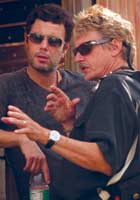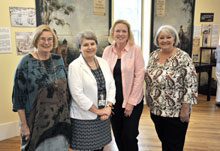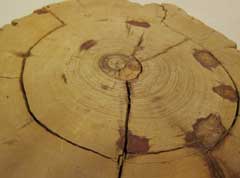 World-renown Dendrochronologist, Henri Grissino-Mayer, uses the science of tree rings to map the past, expose historic frauds and even put a murderer behind bars.
World-renown Dendrochronologist, Henri Grissino-Mayer, uses the science of tree rings to map the past, expose historic frauds and even put a murderer behind bars.
Permanently Stumped
Dr. Henri Grissino-Mayer loves tree stumps. For one of the world’s foremost experts in deciphering the language of tree rings, or dendrochronology, a well-preserved stump is the story of ages and sometimes even millennia. “Trees are nature’s ultimate recorders of what goes on in the environment,” he tells the rapt audience. Mclean Hall at the Technical College of the Lowcountry is filled with professional arborists, foresters and tree lovers of all types for the B3C Tree Symposium. “Trees can talk. I just try and interpret what they say.” The head of the University of Tennessee’s Laboratory of Tree Ring Science is to dendrochronology what Indiana Jones is to Archeology, only minus the bullwhip and fedora.
His lengthy list of academic achievements includes the development of a 2,200 year long reconstruction of annual rainfall for the American Southwest. His lab in Knoxville is routinely inundated with pleas by historical groups and private individuals to scrutinize everything from old buildings to priceless musical instruments. The curators of England’s Ashmolean Museum at Oxford brought in Grissino-Mayer to examine the legendary Stradivarius violin known as “The Messiah” after questions arose regarding its authenticity. Ostensibly made by the master Antonio Stradivari in 1716 and valued at around twenty million dollars, the violin was taken out of its glass case for the first time in more than a century. “I didn’t core it,” Grissino-Mayer jokes. What he did do was dispel any question about the instrument’s authenticity by mapping the tree rings in this most rarified piece of wood. The museum was thrilled.
An American museum claiming to own the log cabin in which Abe Lincoln was born was not so thrilled. Grissino-Mayer’s lab dated the exposed logs a half century later, closer to his presidency than his infancy. Like Honest Abe, says the scientist “Trees do not lie. Just read the rings correctly.” A similar job for the Tennessee Historic Commission revealed a 1787 blockhouse, thought to be one of the oldest structures in the state, to be a hog barn built in 1860.
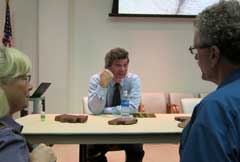 “How’d you know it was a hog barn?” asks someone in the audience.
“How’d you know it was a hog barn?” asks someone in the audience.
“It smelled like pork,” he deadpans.
Dr. Grissino-Mayer and his grad students have been featured in documentaries and programs on the History Channel, Discovery, the National Geographic Channel and Court TV. In 2004 the lab applied forensic dendrochronology to help catch a killer. Rachelle Tolleson was a 20 year-old mother abducted from her Texas home, raped and murdered.
“The killer had tried to burn her body with wood,” explains Grissino-Mayer, “but he hadn’t succeeded.” The night of the murder witnesses at a party saw the suspect toss wood on a bonfire – wood that didn’t burn. Investigators wanted to know if Grissino-Mayer’s lab could match the wood from the crime scene to the wood recovered from the party fire.
“The wood [from both fires] was from the same damn tree!” He says.
It was also the first time tree ring science had ever been applied to a murder investigation.
“A very satisfying case” says the scientist.
The Conversation
Mark Shaffer: It’s official. I now want to be a dendrochronologist in my next life.
Henri Grissino-Mayer: I love, love what I do. Trees have always been my first love. That may be the reason I’m not married.
MS: Well, we know from your presentation that you do spend a lot of time hugging them. (Laughs)
HG-M: I do.
MS: What put you on the path to dendrochronology?
HG-M: I was interested in learning about the past environment when I was an under-grad at the University of Georgia. And I wanted to learn the different techniques to read past environments like ice cores, lake sediments, things like that. Then someone told me about a guy who studies tree rings. This was 1985.
MS: At that time this science is still in it’s infancy on the east coast.
H-GM: Exactly. And so all of a sudden there’s a professor – David Butler – at UGA who was trained out west and he said “Henri, you should do tree rings. I’ll teach you how to do tree rings.” I’ve been hooked ever since. I was amazed at the amount of information you can get from tree rings and the accuracy of that information: earthquakes, volcanic eruptions, drought, frost events, insect outbreaks – I could go on and on. All of this leaves a signature in the tree ring record and all we do is try and find that information in the rings.
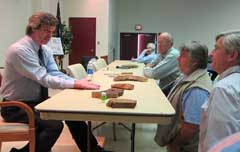 David’s now at Texas State University in San Marcos. I just saw him last week up in Washington, D.C. He’s still one of my best friends.
David’s now at Texas State University in San Marcos. I just saw him last week up in Washington, D.C. He’s still one of my best friends.
MS: You mentioned during your presentation that even with the recent growth of dendrochronolgy in the Southeast, there is no lab in South Carolina. How would the state benefit from a program like yours?
HG-M: Well, several things. I have to turn down so many opportunities to analyze trees or date an historic cabin – things like that. I have to turn them down. Despite the number of labs we now have in the Southeast, the demand is far out-pacing the number of people who can do the work. As tree ring science becomes better known in the Southeast, we just get bombarded with requests. I get asked to date a log cabin once a week. I get asked to date a musical instrument at least once a month. I get asked to conduct a project for Fish & Wildlife or the National Park Service at least twelve to fifteen times a year. I have to say “no” to most of those. Having somebody here in South Carolina would certainly benefit the state. For one thing, there’s so much opportunity to do this type of tree ring work and to learn about the ages of the trees, the historic significance of many of these trees – especially here in Beaufort. Imagine if you had a tree ring lab in Charleston or Columbia at the university.
MS: I’d think this would be a perfect fit at Clemson.
HG-M: Which is a big forestry school. In fact one of the first projects ever done here in the Southeast – back in 1975 – was conducted on short leaf pines in the Clemson forest.
MS: You mentioned in your presentation that we know relatively little about live oaks. I find that stunning considering it’s cultural significance.
HG-M: Isn’t that stunning? It is the most majestic of all oaks. It has no rival. And here in the Lowcountry it’s so strange that we know so little about the ages of these trees. One of the first trees I ever cored was a live oak – a dead one – on Cumberland Island National Seashore in Georgia. It was also the first bore I ever broke in a tree because the wood is so dense. You cannot core a live oak. It will break your five hundred dollar instrument.
MS: Apparently samples are hard to come by for one reason or another. But you have a couple from the Lowcountry including one that Michael Murphy had cut and Deborah Johnson personally delivered to your lab.
H-GM: I remember dating it and I think it had about a hundred and eighty rings. It wasn’t one of the biggest, though. I’ve dated four and the oldest was about a five-foot section that was about two hundred years old. But eventually you’ll have the data Michael’s been collecting on height and diameter and eventually if we can create a database. What we need are more people like Mike and Deborah who can send us samples from downed trees.
MS: One of the reasons you don’t get more samples is that the various commercial lumber interests horde the wood. How do we build the database if we can’t get the samples?
HG-M: I think any tree management program – particularly in an urban environment – should have some sort of provision that provides sections for scientific purposes should trees topple or have to be cut. That should be in every tree ordinance program.
MS: These trees are sold off for lumber, chopped into firewood or they just simply rot away. So, that’s a challenge. But as you’re finding out, you hit town in the middle of a tree management controversy and we’ve got some big challenges here. What are your thoughts on where this town and this region are on dealing with our big trees?
HG-M: My feeling is that the trees should be preserved as much as possible with little interference from people when it comes down to it – as little interference as possible. You can fertilize and the like, but I’m very much against other tree management options.
MS: Like aggressive pruning, courtesy of the power company?
HG-M: Exactly. I’m not going to question why these things had to be done but I do know that this is not the only community where there’s been a controversy. In my hometown of Athens, Georgia, with their majestic oaks there was also controversy about pruning these beautiful, beautiful trees that had been around since before the Revolutionary War. And many of them did not make it. This was about twenty-five years ago and we’ve learned a lot since then. There is no easy answer when it comes down to it. For one thing, I like electricity. I like my air conditioning. On my street in Knoxville [the power company] just came down the street and took out one whole side of the tree line with a big saw. It’s tragic. It looks terrible now.
MS: And they’re not supposed to do that, but it happens a lot. And it seems to have a lot to do with contractors and sub-contractors, not tree management. There’s real concern here that we’ll lose some of our famous canopies if something’s not done.
HG-M: It’s really a shame and I understand that there’s no easy answer. Why not just move the power lines?
MS: Money.
HG-M: It’s always cheaper and easier to prune beautiful trees rather than move some power lines. But I can guarantee you that those trees have been there a lot longer than those power lines. Why not bury the lines? We’re doing more and more of that in Knoxville. I spent nine years in Tuscon, Arizona. Everything’s under ground, there are no power lines and it’s beautiful.
MS: What are some of the neatest discoveries you’ve made?
HG-M. There are so many and every project I work on has a story. I love stories. I love being involved in something even when it’s controversial. My philosophy is that I’m not doing good science unless I make someone mad. I tell my students, “You’re not doing good science unless you piss someone off.” That’s the truth and the reality is the truth hurts sometimes. One of the most satisfying things I’ve worked on was the Rachelle Tolleson [murder] case. I never knew a project could affect me so much.
MS: To the best of you knowledge is that the first time dendrochronology has been used in a murder case?
HG-M: Yes. In fact, it became an episode of Forensic Files and it’s been highlighted several times on TV. As far as the biggest “Eureka!” moment, it’s a piece of wood that I collected on the lava flows of New Mexico that we’d been walking over for about three years. On the last of seven trips we collected it and I’ll be darned if it didn’t break what we call “The B.C. Barrier” – to actually find a piece of wood that pre-dates Jesus Christ. This to me is one of those spiritual moments. I’m very Christian and when I find a piece of wood like that I go “Wow! This means much more than just the tree rings.”
Find out more about dendrochronology and Henri Grissino-Mayer online at http://web.utk.edu/~grissino
Get more Lowcountry online at www.lcweekly.com and look for us on Facebook.


